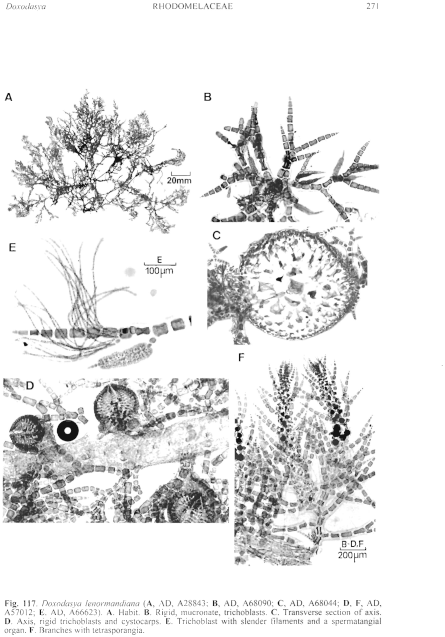|
|
|
|
|
|||||||||||
|
Electronic Flora of South Australia Species Fact Sheet
Phylum Rhodophyta – Family Rhodomelaceae – Tribe Lophothalieae
Selected citations: De Toni 1903: 1022. Lucas 1909: 43. Lucas & Perrin 1947: 287. May 1965: 378.
Synonyms
Dasya lenormandiana J. Agardh 1863: 1238. Sonder 1880: 36.
Lophothalia lenormandiana (J. Agardh) J. Agardh 1890: 63. Schmitz 1893: 220.
Thallus (Fig. 117A) dark red-brown, 5–25 cm high, radially and irregularly much branched with several relatively slender main axes or branches 0.5–1 mm in diameter, laterals laxly branched for 2–3 orders with lesser branches covered with short shoots 2–3 mm long, bearing rhodoplastic trichoblasts 0.5–1 mm long. Cortication commencing shortly below apices but usually slight, becoming thicker on main branches, with the pericentral cells remaining clear in transverse section (Fig. 117C). Holdfast of slender fibres, bearing short, branched, processes; epilithic or epiphytic. Structure monopodial with a conical apical cell, axial cells 3 or 4 below apices producing trichoblasts spirally from each segment, with 4 pericentral cells formed from about the sixth axial cell. Trichoblasts rigid (Fig. 117B, F), with 1–4 branches in varying planes and 1–4 cells apart near their base, 0.5–1 mm long, lower cells 60–90 µm in diameter and L/D 1–1.5 (–2), tapering to subterminal cells 20–30 µm in diameter and L/D 1–1.2, terminal cell mucronate (Fig. 117B); dichotomies with basally adherent walls (as in Dasya). Many trichoblasts bear, sparsely to prolifically, from their mid cells small tufts 0.5–1.5 mm long (Fig. 117E) of slender, lax, filaments, each with a rounded basal cell then filaments branched 2–6 times, 5–8 µm in diameter, mature cells L/D 8–12. Lateral branches arising from basal cells of trichoblasts. Cells multinucleate; rhodoplasts discoid to chained.
Reproduction: Gametophytes dioecious. Procarps borne on the supra-basal cells of trichoblasts, this and the basal segment becoming polysiphonous and corticated. Carposporophytes with a basal fusion cell and branched gonimoblast filaments bearing clavate terminal carposporangia, 25–35 µm in diameter, replaced from below. Cystocarps (Fig. 117D) urceolate, 600–800 µm in diameter, short stalked, with a distinct neck 180–250 µm long; pericarp ostiolate, 4–5 cells thick. Spermatangial organs (Fig. 117E) on branches of trichoblasts, usually with a sterile basal cell and tip of 5–8 cells, fertile parts 120–200 µm long and 35–55 µm in diameter.
Tetrasporangial stichidia (Fig. 117F) with simple or once branched trichoblasts and decussate pairs of tetrasporangia, 400–800 µm long and 70–130 µm in diameter; tetrasporangia (25–) 40–70 µm in diameter.
Type from Glenelg R. mouth, Vic.; holotype in Herb. Lenormand, CN, fragment thereof in Herb. Agardh, LD, 42095.
Selected specimens: Seal Bay, Kangaroo I., S. Aust., drift (Womersley, 21.i.1965; AD, A28843). Pennington Bay, Kangaroo I., S. Aust., drift (Womersley, 11.ii.1956; AD, A20139). Blackfellows Caves, SE S. Aust., drift (Womersley, 20.xi.1998; AD, A68043). Port MacDonnell, S. Aust., drift (Womersley, 21.viii.1966; AD, A30697, on Laurencia filiformis, 16.x.1985; AD, A57012, and 29.ix.1996; AD, A66623 and 4.iv.1999; AD, A68090).
Distribution: Seal Bay, Kangaroo I., S. Aust., to the Glenelg R. mouth, Victoria.
Taxonomic notes: Doxodasya lenormandiana is apparently not a common species, known only from drift on rough-water coasts. It is characterised by habit and the rigid, large-celled, trichoblasts which bear tufts of very slender filaments.
References:
AGARDH, J.G. (1863). Species Genera et Ordines Algarum. Vol. 2, Part 3, pp. 787–1291. (Gleerup: Lund.)
AGARDH, J.G. (1890). Till algernes systematik. Acta Univ. lund. 26(3), 1–125, Plates 1–3.
DE TONI, G.B. (1903). Sylloge Algarum omnium hucusque Cognitarum. Vol. 4. Florideae. Sect. 3. pp. 775–1521 + 1523–1525. (Padua.)
LUCAS, A.H.S. & PERRIN, F. (1947). The Seaweeds of South Australia. Part 2. The Red Seaweeds. (Govt Printer: Adelaide.)
LUCAS, A.H.S. (1909). Revised list of the Fucoideae and Florideae of Australia. Proc. Linn. Soc. N.S.W. 34, 9–60.
MAY, V. (1965). A census and key to the species of Rhodophyceae (red algae) recorded from Australia. Contr. N.S. W. Natl Herb. 3, 349–429.
SCHMITZ, F. (1893). Die gattung Lophothalia, J. Ag. Ber. Deutsch. Bot. Ges. 11, 212–232.
SONDER, O.W. (1880). In Mueller, F., Fragmenta Phytographiae Australiae. Supplementum ad volumen undecinum: Algae Australianae hactenus cognitae, pp. 1–42, 105–107. (Melbourne.)
The Marine Benthic Flora of Southern Australia Part IIID complete list of references.
Publication:
Womersley, H.B.S. (24 February, 2003)
The Marine Benthic Flora of Southern Australia
Rhodophyta. Part IIID. Ceramiales – Delesseriaceae, Sarcomeniaceae, Rhodomelaceae
Reproduced with permission from The Marine Benthic Flora of Southern Australia Part IIID 2003, by H.B.S. Womersley. Australian Biological Resources Study, Canberra. Copyright Commonwealth of Australia.
Illustration in Womersley Part IIIA, 2003: FIG. 117.

Figure 117 enlarge
Fig. 117. Doxodasya lenormandiana (A, AD, A28843; B, AD, A68090; C, AD, A68044; D, F, AD, A57012; E, AD, A66623). A. Habit. B. Rigid, mucronate, trichoblasts. C. Transverse section of axis. D. Axis, rigid trichoblasts and cystocarps. E. Trichoblast with slender filaments and a spermatangial organ. F. Branches with tetrasporangia.

|
Email Contact: State Herbarium of South Australia |

|